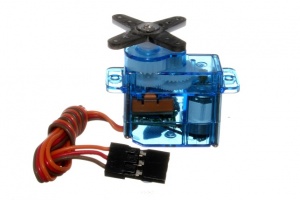Servomotor
Summary: For model railroading purposes, servomotors from the Radio Control aircraft hobby are popular. They are often referred to as servos or RC Servos. They are constructed using a small motor with a set of reduction gears driving the output shaft. A potentiometer is used to sense the position of the shaft. Additional electronics are needed to control the motor.
Model Railroading and Servomotors
For model railroading purposes, servomotors from the Radio Control aircraft hobby are popular. They are often referred to as servos or RC Servos. They are constructed using a small motor with a set of reduction gears driving the output shaft. A potentiometer is used to sense the position of the shaft. Additional electronics are needed to control the motor.
Proportional Control
In operation, a signal is generated by the controller, and the motor responds by moving in the direction needed to balance the system and cancel the error between its position and the commanded position. When the system is in balance the motor stops moving. This allows precise positioning of the shaft. The shaft mounted potentiometer is used to create the feedback needed to control the motor.
This is called proportional control, as the motor has no fixed positions and can respond proportionately to the control signal. In the case of an RC airplane, the servo's response is related to the inputs from a joystick. For model railroads, the speed is usually fixed and the positions are preset to actuate a turnout, crossing gates or a semaphore signal.
Servos need a 5V to 6V power supply and a special Pulse Width Modulated (PWM) control signal.
DCC Multifunction and Accessory Decoder Applications
Some DCC mobile decoders and accessory decoders are capable of driving RC servos. On locomotives servos can be used for uncouplers. With accessory decoders servos can be used to operate turnouts, crossing gates and semaphore signals in a prototypical manner.
The Tam Valley Depot Singlet Servo DCC Accessory Decoder is an example of a DCC servo decoder for operating turnouts, etc.
Most of the current Zimo mobile decoders (except the MX621) have 2 servo outputs. The larger (G scale) Zimo decoders (MX695, MX696) have 4 servo outputs. Zimo's miniature accessory decoders (MX820, MX821) also have servo outputs.
Micro-controllers such as the Arduino can also be used to control servos.
